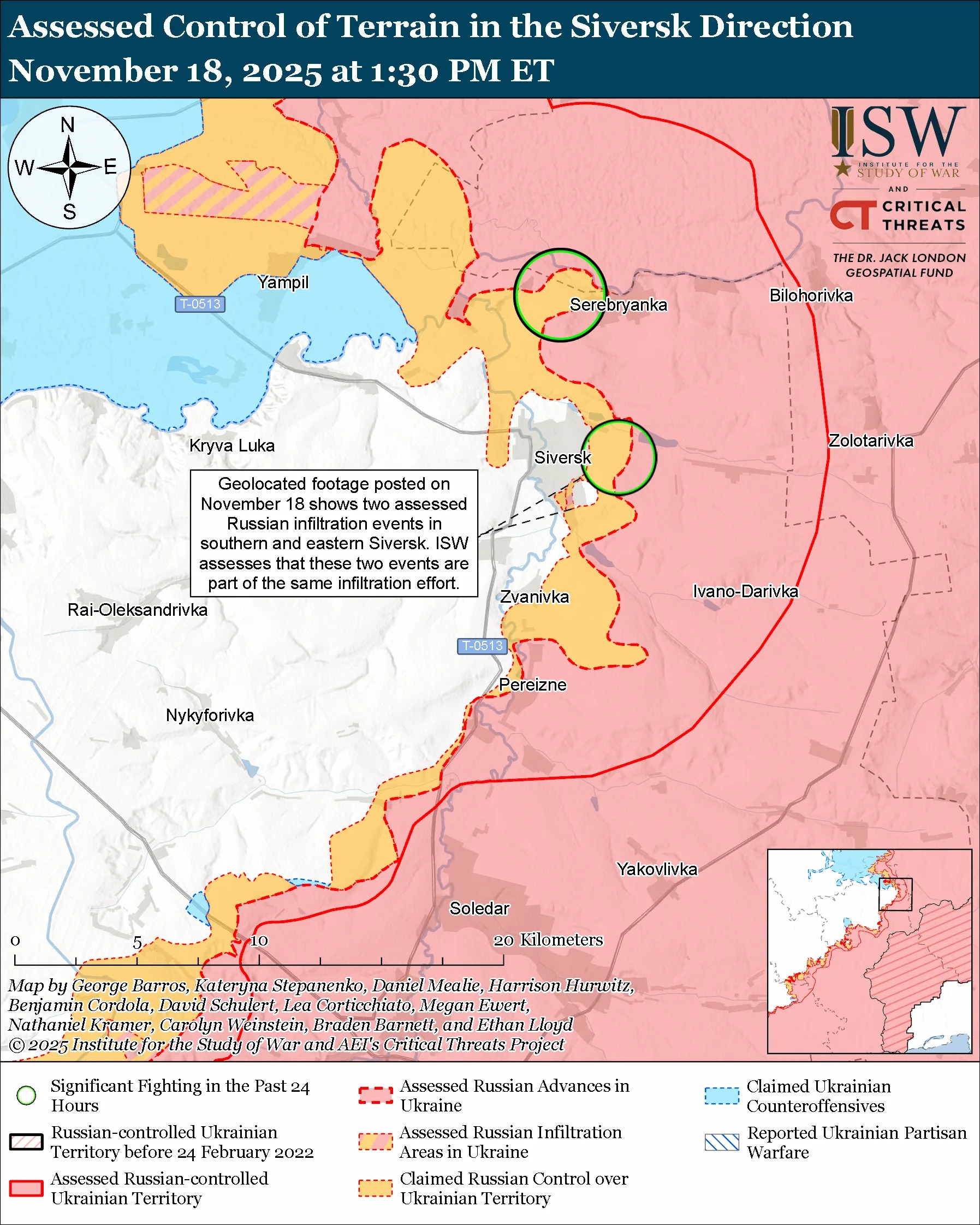Russian forces are testing a new tactical campaign design in the Siversk and Sloviansk–Lyman directions as they try to develop conditions for future pressure on Ukraine’s Fortress Belt, according to the Institute for the Study of War. This operational model relies on stealth, drones, weather conditions, and gradual infiltration—not direct large-scale assaults.
Russia pilots new infiltration-heavy template near Fortress Belt
Russian forces are experimenting with a new offensive approach that centers on battlefield air interdiction, tactical raids, infiltration missions, and saturation drone strikes. ISW says this “operational template” has already been used in Pokrovsk, Velykomykhailivka, and Huliaipole. Now, Moscow is trying to replicate the same method around Siversk and Lyman in northern Donetsk Oblast.
Geolocated footage published on 18 November showed Russian units, including elements of the 123rd Motorized Rifle Brigade of the 3rd Combined Arms Army, infiltrating into southern and eastern Siversk. However, ISW stressed that this movement did not alter the control of terrain or the forward line of the battlefield. A Russian milblogger claimed that the observed infiltrations in southern Siversk may indicate that Russian forces plan to covertly build up troops inside the town and repeat what they had done in Pokrovsk.
The Russian Ministry of Defense claimed that elements of the 7th Motorized Rifle Brigade seized Platonivka, northwest of Siversk, using a feint under fog and rain with FPV drone and artillery support, enabling interdiction of the T‑0513 Lyman–Siversk highway. However, ISW has seen no visual confirmation, and a Ukrainian military intelligence-linked source said on 17 November that Russian forces were blocked from reaching the road.
Drone-led coordination and infiltration efforts intensify around Lyman
Russian forces are applying similar tactics in the Sloviansk–Lyman direction. According to a spokesperson for Ukraine’s 3rd Army Corps, Russian troops have been trying to infiltrate and establish forward positions in the Lyman area to enable future flank attacks and semi-encirclements of Ukrainian units.
These operations are reportedly timed for foggy and rainy conditions, which hinder Ukraine’s drone capabilities. The spokesperson stated that Russian forces are attempting to “overwhelm” Ukrainian defenses—likely referring to Ukraine’s tactical “wall of drones.” At the same time, drone strikes and infiltration missions aim to sever Ukrainian logistics and lay the groundwork for larger assaults.
A non-commissioned officer of a Ukrainian brigade stationed in the Lyman direction said on 18 November that Russian forces use FPV drones and fiber-optic sleeper drones to coordinate artillery strikes ahead of attacks.
ISW says Russia struggles to scale the tactic
ISW previously assessed that Russian troops initially made significant gains around Pokrovsk using a mix of air interdiction, infiltration, and poor weather conditions to bypass Ukrainian drone barriers and exploit weaknesses in defensive lines.
While Russia is now trying to extend that campaign model to Siversk, Lyman, Velykomykhailivka, and Huliaipole, ISW noted that Moscow is already encountering problems sustaining the approach. In the Pokrovsk direction itself, Russian forces are faltering in maintaining coherent pressure using this method.
According to ISW, if Russia hopes to pressure the Fortress Belt—the main Ukrainian defense line in Donetsk Oblast—it will need to allocate more manpower, equipment, and time to replicate the limited success it saw in Pokrovsk.
Read also
-
ISW: Russia can’t seal the east — so it tries to fix Ukrainian troops in Pokrovsk from the west (MAP)
-
A chilling echo of Vuhledar: Russia repeats ‘meat grinder’ tactic on a new front
-
ISW: Russia crosses Vovcha River in fog, breaks into Novopavlivka, highlighting “Ukraine’s need for traditional weapons systems” (MAP)

